Texas
![]()
This article is about the US state of Texas; for other meanings, see Texas (disambiguation).
Texas (English [![]()
![]() ˈtʰɛksəs] or [ˈtʰɛksɪs], from cadd. táyshaʔ 'friends' or 'allies') is a state in the south-central United States of America. Texas is nicknamed the Lone Star State because of the single star on its flag. Of all the U.S. states, Texas has the second largest land area after Alaska and the second largest population after California. With its 254 counties, Texas has the most counties of any state in the United States.
ˈtʰɛksəs] or [ˈtʰɛksɪs], from cadd. táyshaʔ 'friends' or 'allies') is a state in the south-central United States of America. Texas is nicknamed the Lone Star State because of the single star on its flag. Of all the U.S. states, Texas has the second largest land area after Alaska and the second largest population after California. With its 254 counties, Texas has the most counties of any state in the United States.
Texas borders Mexico to the south. This makes up about half of the border between the United States and Mexico. In addition, Texas borders the states of New Mexico to the west, Oklahoma to the north, Arkansas to the northeast and Louisiana to the east.
Population
| Population development | |||
| Census | Inhabitants | ± in % | |
| 1850 | 212.592 | - — | |
| 1860 | 604.215 | 184,2 % | |
| 1870 | 818.579 | 35,5 % | |
| 1880 | 1.591.749 | 94,5 % | |
| 1890 | 2.235.527 | 40,4 % | |
| 1900 | 3.048.710 | 36,4 % | |
| 1910 | 3.896.542 | 27,8 % | |
| 1920 | 4.663.228 | 19,7 % | |
| 1930 | 5.824.715 | 24,9 % | |
| 1940 | 6.414.824 | 10,1 % | |
| 1950 | 7.711.194 | 20,2 % | |
| 1960 | 9.579.677 | 24,2 % | |
| 1970 | 11.196.730 | 16,9 % | |
| 1980 | 14.229.191 | 27,1 % | |
| 1990 | 16.986.510 | 19,4 % | |
| 2000 | 20.851.820 | 22,8 % | |
| 2010 | 25.145.561 | 20,6 % | |
| 2020 | 29.145.505 | −17,1 % | |
| Before 1900 1900–1990 2000 | |||
Ethnicities
Texas had a 2010 population of 25,145,561 (2010 US Census), of which 45.3% were white (excluding Hispanics and Latinos), 11.8% were African American, 3.8% were Asian, 0.7% were Native American, 0.1% were Hawaiian or from other Pacific Islands. 2.7% belonging to two or more groups. 37.6% of the total population were Hispanics. In 2010, minorities made up 50.2% of the population. Texas is thus considered a Majority-Minority state. As of mid-2017, the population is estimated at 28,304,596. The population of Texas is among the fastest growing in the United States.
Age structure
2014 were
- up to 18 years: 7,116,637 (26.4 %)
- 18-64 years: 16,740,270 (62.1 %)
- 65 years or older: 3,100,050 (11.5 %)
The median age was 34.3 years (national average of the 50 US states: 37.7 years). 49.6% of the population was male and 50.4% female.
Ancestry
9.6% of the inhabitants are of German descent and thus form the largest group after those of Mexican descent (as of 2014). They are followed by the groups of Irish (6.9 %), English (6.2 %), American (5.6 %) and French descent (2.0 %).
Religions
The major religious denominations in 2000 were the Roman Catholic Church (with 4,368,969 members), the Southern Baptist Convention (3,519,459 members), and the United Methodist Church (1,022,342 members). In addition, there are many other denominations, mainly Protestant.
Population distribution
Large parts of east, north and central Texas are inhabited by whites who belong to Protestant churches. They are primarily descendants of immigrants from Britain and Ireland. Large parts of central and southeast-central Texas are inhabited by whites who have German ancestors. African Americans, who historically made up one-third of the population, live primarily in the parts of Texas where cotton plantations were especially prevalent before the Civil War and in Dallas and Houston.
Largest cities
Population 2000/2010: U.S. Census 2000 (green) and U.S. Census 2010 (red)
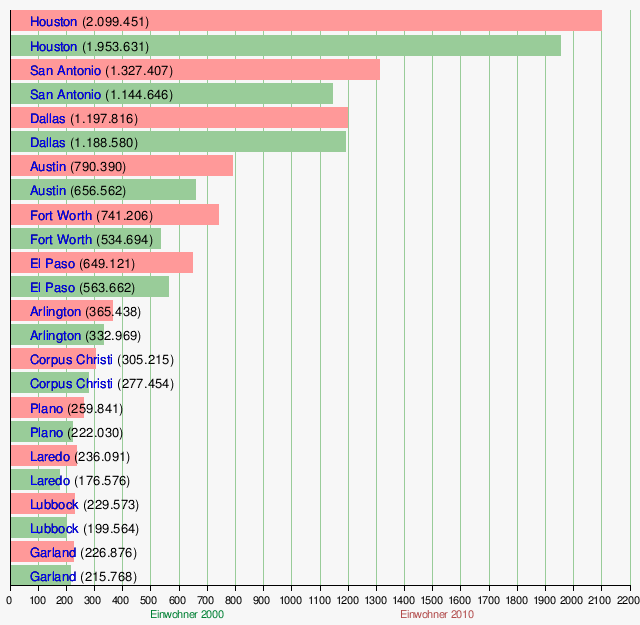
- See also: List of cities in Texas and List of cities in Texas by population.
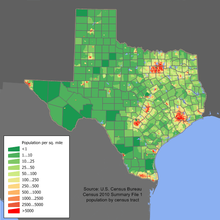
Population density
History
Prehistory
The oldest datable finds of human artifacts in North America to date have been made in Texas. In the Buttermilk Creek Complex in Bell County, stone tools and flakes dating to between 15,500 and 13,200 years ago were discovered under a Clovis Culture find horizon.
Texas lies in two of the North American cultural areas, the Prairies and Plains on the one hand, and the Southwest on the other. The Texan Paleoindians of the period 9200 to 6000 BC were related to the Clovis culture and that of Folsom. They left traces primarily in the north, in what is now Alibates Flint Quarries National Monument. They lived by hunting mammoth and bison (bison latifrons). The oldest finds were made with the Midland Man found in Midland County in 1953, a woman discovered near Leander in Williamson County in 1983, and a man and boy near Waco. Petroglyphs appeared on the Pecos River around 4000 BC. The first corn farmers lived on the lower Pecos around 1500 BC.
Around 500 B.C., a sedentary culture emerged in the east under the influence of the Mississippi region; beyond the Rio Pecos, the Mogollon culture dominated.
After 700, the bow began to displace the spear sling (atlatl), pottery was made. Trade in obsidian reached as far north as the Rocky Mountains, in the south especially as far south as Teotihuacán. Between about 800 and 1500, the so-called Buried City existed, stone dwellings southeast of Perryton in Ochiltree County.
The Plains Village People, who lived around 1150 to 1450, are considered the ancestors of the Caddo, Pawnee, and Wichita. They lived in permanently inhabited large villages whose houses consisted of one room, but also as many as a hundred. Before 1500 they were driven westward, probably by Apaches.
The cultures were divided into numerous ethnic groups of varying composition when the Spanish arrived. They included the Alabama, Apache, Atakapan, Bidai, Caddo, Coahuiltecan, Comanche, Cherokee, Choctaw, Coushatta, Hasinai, Jumano, Karankawa, Kickapoo, Kiowa, Tonkawa, and Wichita.
Today there are only three tribes in Texas recognized by the federal government in the 1960s and 1970s, the Alabama Coushatta, which resulted from the merger of a group of the Alabama with the Coushatta, the Kickapoo Traditional Tribe of Texas (on the Rio Grande in Maverick County), and the Ysleta del Sur Pueblo in El Paso and Socorro. In addition, there is a South Texas subgroup of the Kickapoo Tribe of Oklahoma. They had been driven into Mexico by the Republic of Texas in 1839.
Spanish
In 1519, the Spaniard Alonso Álvarez de Pineda made the first cartographic survey of the Texas coast. This was also the beginning of the Spanish occupation of the territory. In 1528, the Spaniard Cabeza de Vaca was shipwrecked on the coast in the area of present-day Galveston. A small group of survivors marched across the Indian territories to Mexico City and later caused the legend of the "Seven Cities of Gold" to spread. The Spanish adventurer Coronado, attracted by this story, traversed the western part of Texas and parts of present-day New Mexico up into Kansas. Although he did not find the golden cities, the rumor still persisted through the centuries.
Subsequently, many towns and especially missions sprang up in what is now Texas. In 1621, Spanish immigrants founded the town of Corpus Christi de la Isleta. In 1659 El Paso followed.
A French colonization attempt on the territory of Texas occurred in 1685. The adventurer Robert Cavelier de La Salle reached Matagorda Bay by ship and founded Fort St. Louis there. However, the settlement suffered greatly from Indian attacks, disease, and the loss of important materials through shipwrecks. Just two years later, La Salle was murdered by his own people while trying to get help. St. Louis was then abandoned; Texas was Spanish again. However, the French were able to hold their own in the settlements in the delta of the Mississippi River. In 1686 to 1689 Alonso de Leon, governor of Coahuila, searched the French colony and found few survivors.
In the course of another Spanish expedition, several mission stations were founded. This is how the Mission San Antonio de Valero came into being in 1718. Over 100 years later, this mission went down in history as The Alamo. In 1786, Pedro Vial found a trail from San Antonio to Santa Fe, but it did not become important as a trade route.
Mexico
In 1821, Texas became part of Mexico, which became independent from Spain. Already during the Mexican War of Independence many adventurers from the United States accumulated here. In 1823, after North American Colonel Stephen F. Austin received permission from the central government of Mexico to settle in the Texas territory with 300 families, he founded the town of San Felipe de Austín. Austin's agreement was very simple. He had to exchange his U.S. citizenship for Mexican citizenship and was thus subject to Mexican jurisdiction. More and more settlers from the north reached the Gulf of Mexico. It was the beginning of Anglo-American colonization, by 1835 about 45,000 people from the north settled in Texas.
Tensions between American settlers on the one hand and Mexicans and the Mexican government under President General Santa Anna on the other grew more intense when Mexico outlawed slavery. Because the United States wanted to buy the entire state of Texas, Mexican land authorities banned further immigration from the United States in 1830. Religious, cultural, and political problems in particular seemed insurmountable. But new laws and ordinances granted so many exceptions and freedoms to Texas settlers that tensions diminished and 1835 was at first a relatively quiet year. Land speculators from the United States, however, fueled distrust of Mexico. When Stephen F. Austin was imprisoned during a visit to Mexico City and, on the basis of personal disappointment, opposed remaining in Mexico, separatists saw their opportunity. Upon Austin's return, they declared Texas' secession from Mexico in a hastily called meeting. Santa Anna sent troops (about 5000 men) to Texas shortly thereafter because of this. On October 2, 1835, the War of Texas Independence began with the Battle of Gonzales.
Republic of Texas
→ Main article: Texan War of Independence
On March 2, 1836, the Texans, relying on the assistance of the Democratic party in the United States, which advocated an increase of slave states, proclaimed the independent Republic of Texas and appointed General Sam Houston as military commander-in-chief. The Mexican army under Santa Anna occupied San Felipe de Austín, the capital of Texas, in the course of hostilities.
On March 6, 1836, the mission town of Alamo was taken by the Mexicans after a thirteen-day siege. All of the 190 or so defenders were killed, including Davy Crockett, James Bowie and William Travis.
The Mexican forces of about 1600 soldiers were surprisingly defeated by the Texans under Sam Houston at the Battle of San Jacinto on April 21, 1836. The Mexican president, General Santa Anna, was taken prisoner. In the following years, the Mexican government attempted to reverse Texan independence through further military expeditions; but failed.
As an independent republic, Texas was recognized by France and the United Kingdom on November 23, 1839, and November 14, 1841, respectively. The first president of the independent nation and republic of Texas was Sam Houston. Stephen F. Austin became Secretary of State for his state, but died of a lung ailment just two months after taking office.
Domestically, the young Republic of Texas was divided into two camps. One group, led by Sam Houston, advocated a quick entry into the United States. The other group, led by Mirabeau B. Lamar, the republic's second president, wanted to avoid such a move. Instead, expansion of the Republic of Texas to the Pacific Ocean was thought of. In doing so, Texas was to form a quasi-buffer state between Mexico and the United States. In the end, the group around President Houston prevailed, who had held this office with interruptions until shortly before the union with the USA and also became governor of the US state from 1856 to 1861.
US state
The country was annexed by the United States on February 19, 1845; the U.S. Congress approved the annexation on March 1, 1845. It was admitted into the Confederacy on December 29, 1845. Over this the Mexican-AmericanWar broke out in 1846, ending on February 2, 1848, with the Treaty of Guadalupe Hidalgo. Mexico renounced its claims to Texas and the territory between the Rio Grande and the Nueces River, but the United States government, by resolution of September 7, 1850, assigned a portion of this territory to New Mexico, which in the meantime had been annexed to the Union as a territory. Texas received a compensation of $10 million for this.
The election victory of Abraham Lincoln, known for his strict principles on the slavery issue, in the presidential election of November 6, 1860, triggered, beginning with South Carolina on December 20, 1860, the secession of the slaveholding Southern states from the Union. Texas, whose declaration of secession adopted at a convention in Austin on February 1, 1861, was approved by referendum on February 23 and thus took effect on March 2, was the seventh and last Southern state to secede from the Union before Abraham Lincoln's inauguration on March 4 and the beginning of the War of Secession, joining the Confederate States of America formed in early February 1861 (see also Texas Germans in the American Civil War). After the War of Secession ended in 1865, U.S. President Andrew Johnson installed Unionist Andrew Jackson Hamilton as provisional governor of Texas. The process of Reconstruction ended for Texas on March 30, 1870, when Texas representatives were readmitted to the United States Congress.
To this day, the erroneous modern myth persists that Texas is the only U.S. state that has the right to re-exit the United States at will because it was admitted to the Union by entering into a treaty.
German immigrants
German immigrants have played a major role in shaping the US state. Caroline Ernst and her family were the first German settlers. A rapturous letter from her father to Germany in 1832 was one of the triggers for German involvement in Texas.
Organized German immigration began in 1834 with the Thirties and was primarily due to the Giessen Emigration Society and the Association for the Protection of German Immigrants in Texas, also known as the Mainzer Adelsverein. After the March Revolution of 1848, some of the Forty-Eighters still followed.
At the beginning of the 20th century, about 100,000 Texans were German-speaking. Most settled in Central Texas in the so-called Texas Hill Country, the German Hills in the Austin and San Antonio area. Early settlements were the Latin Settlements, founded by German emigrants. The influence of World War I, in particular, led to a marked decline in the German language. The German-English mixed dialect is also called Texas German.
The influence of German immigrants can be seen in place names such as New Braunfels (founded in 1845 by Carl Prinz zu Solms-Braunfels, a member of the Mainz Adelsverein) and the name of the water park Schlitterbahn. In New Braunfels, about 65 km south of the capital Austin, the sausage festival is celebrated annually. The Gruene district, founded in 1872 by Henry D. Gruene, is home to the oldest surviving dance hall in Texas, Gruene Hall. It is now a historic venue for live music and dance events.
Also near Fredericksburg (founded in 1846 and named "Friedrichsburg" in honor of Prince Frederick of Prussia (1794-1863), another member of the Mainz Nobility Society) is a German colony. The local chamber of commerce greets visitors on the Internet with "Welcome", and restaurant menus are sometimes bilingual.
The settlement Luckenbach also became known here, which was mentioned in a song interpreted by Waylon Jennings and Willie Nelson with the title Luckenbach, Texas. The song made it to number 1 in the US country charts. Up to 20,000 Texans still speak German today.
Sorbs from Lusatia also emigrated in significant numbers to Texas in the mid-19th century and founded the settlement of Serbin there under the leadership of Jan Kilian, among others. Although the inhabitants have not spoken Sorbian for a long time, the Texas Wendish Heritage Museum and a Wendish Heritage Society are reminders of this chapter of Texas history.
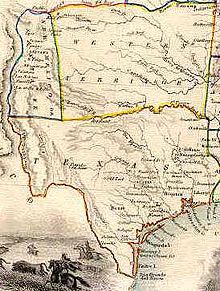
Old map of the southeast
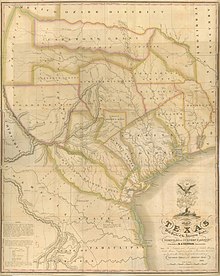
Map by Stephen F. Austin, 1836
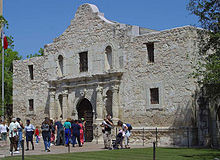
The Alamo in Texas
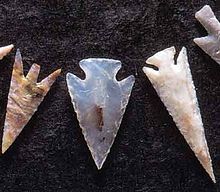
Projectile points from Alibates Flint Quarries National Monument in north Texas. The finds there date back to 11000 BC.
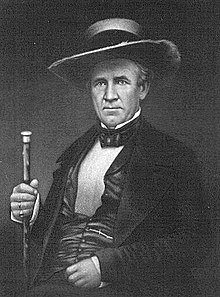
Sam Houston

Robert Cavelier de La Salle
Questions and Answers
Q: What is the second largest US state by total area?
A: Texas is the second largest US state by total area, with 268,596 sq mi (695,662 km2).
Q: What are some of the major cities in Texas?
A: The major cities in Texas include Houston, Dallas, Fort Worth, San Antonio, El Paso and Austin.
Q: When did Texas become a part of the United States?
A: Texas became the 28th state in the United States in 1845.
Q: What is the nickname for Texas?
A: The nickname for Texas is "Lone Star State".
Q: What are some tourist attractions in Texas?
A: Some tourist attractions in Texas include Fort Worth's stockyards, Amarillo's cattle business and stockyards, The Alamo in San Antonio, Johnson Space Center in Houston and University of Texas at Austin in Austin.
Q: What other important universities are located within the state of Texas?
A: Other important universities located within the state of texas includeTexas A&M University College Station ,Texas Tech University Lubbock ,Baylor University Waco and University of North Texas Denton.
Search within the encyclopedia